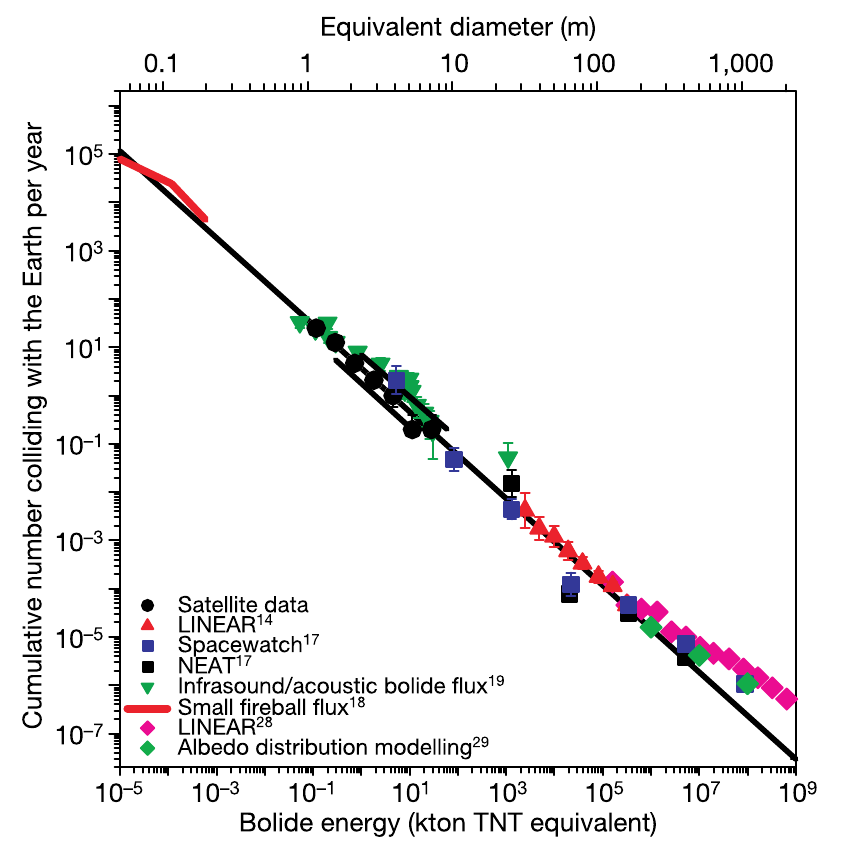How frequently do large meteoroids hit us?
Posted on Fri 15 February 2013 in meteors
The internet is buzzing about a fireball which caused a powerful sonic boom over Chelyabinsk in Russia, injuring hundreds. A question asked by many is: how common is such event?
Answer: more common than you might think!
The population of Solar System bodies which cross Earth's orbit range from mm-sized dust (producing meteors) to km-sized asteroids (producing mass extinctions). The frequency of such objects is constrained by meteor observations on one hand (there are ~1000 visible meteors per second across the planet), and asteroid surveys on the other hand (a 10km body will hit us every ~100 million years).
The object that struck Russia falls somewhere in the middle of this range. We know that a meteoroid needs to be larger than 1 meter in diameter to penetrate deep enough into the atmosphere to cause a significant airburst (though velocity, entry angle and composition are important too). At the same time, the scale of destruction is a lot smaller than the famous Tunguska event in 1908, which is thought to have been caused by a 50m-sized body. Hence a first guess for the size of the Russian meteoroid would be "between 1 and 20 meter".
We don't know the frequency of asteroids in this size range very well. There are not enough meteor observing cameras to detect these rare events, yet the objects are too small and faint to be detected by telescopes ahead of their impact (apart from one notable exception in 2008).
There is an industry that is very successful in detecting these impacts however; military space surveillance. The US Defense and Energy departments operate satellites to detect the heat signatures from nuclear weapons and rocket launches from space. In 2002, a team led by Professor Peter Brown obtained access to classified data on 300 large fireballs detected between 1994 and 2002 by the military. The authors combined this information with ground-based observations to estimate the relationship between the size of meteoroids and their impact frequency:

The relationship between the size of meteoroids and their impact frequency. Credit: Brown et al. 2002 (Figure 4).
The work by Brown et al. may approximately be summarized as follows:
- a 10cm-body hits us every few minutes;
- a 1m-body every few months;
- a 10m-body every few years to decades;
- a 100m-body every few millenia.
Hence, a fireball like the one in Russia is likely to occur somewhere between every few years and every few decades, but the uncertainty is large. Shifting the trend slightly upwards or downwards can change the estimated frequencies by a factor of several, and so we should be careful to pin down any numbers with large confidence.
Whilst the Russian meteor appears to be the largest recorded event for a century, it would be imprudent to infer that it hence only occurs once a century. It is difficult to rely on historical records of the past, because less than 20% of the surface of our planet is inhabited, and so many impacts might have gone unnoticed. In fact there is some evidence for a possible 'Brazilian Tunguska' on 13 August 1930 and a 'Guyana Tunguska' on 11 December 1935, but events like these may have been undocumented or forgotten.
Moreover, there are reasons to believe that the impact frequencies are not constant, but may be elevated during certain periods (see my recent talk on this topic). Unfortunately, the US military announced in 2009 that they will no longer share fireball observations with scientists, so we'll have to come up with other ways to pin down the exact danger coming from small asteroids!